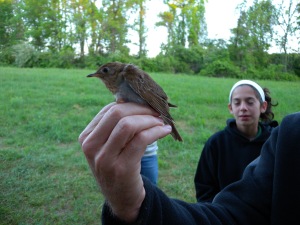Our Banding team completed three productive days during the week of May 16 through the 21st despite unrelenting rain. We continued to catch migrants stopping at “Hotel Rushton” for food and rest on their way north. We also had a visit from human migrant, Natalie Staples, our former intern and budding writer whose college essay was inspired by her banding with us two years ago. She was as excited as ever to rejoin us banding during her break from Kenyon College and this illustrated an important part of what Rushton banding is all about.
Capturing the talent and imagination of young people on behalf of avian research, conservation and education are lofty goals which we hope to achieve.
Speaking of talent and imagination, Saturday, May 21, was dedicated to young birders and they came in droves! Our visitors totaled 65 on a sunny day with lots of cooperative birds jumping into our nets. We welcomed more than 40 youngsters from 4 to 18 years old, along with parents, teachers, and mentors from several partnering organizations. The Episcopal Academy Bird Club led by our volunteer, Win Schafer, was our middle school population, while an older group of experienced birders came from Upper Main Line Y. PA Young Birders from the Delaware Valley Ornithological Club (http://www.payoungbirders.org/PA_Young_Birders/Welcome.html ) were also part of the mix. The very youngest birders were members of the Rushton Junior Bird Club.
Banders demonstrated band application, measuring, ageing and sexing birds. Kids got close views of wings, tail feathers, brood patches and even ticks attached around the birds’ eyes.
Seeing the kids visual acuity reminded all of us “older kids” that young eyes are extremely useful for birdwatching. One young birder spotted a Common Nighthawk roosting in a tree, which sent visitors rushing to see a bird most people won’t see in a lifetime. Not a hawk at all, it’s actually a member of the nightjar family and please read more about this fascinating bird here: http://www.allaboutbirds.org/guide/Common_Nighthawk/id
Stay tuned for our last update, which is slightly delayed due to our busy spring schedules.
Doris and Lisa










